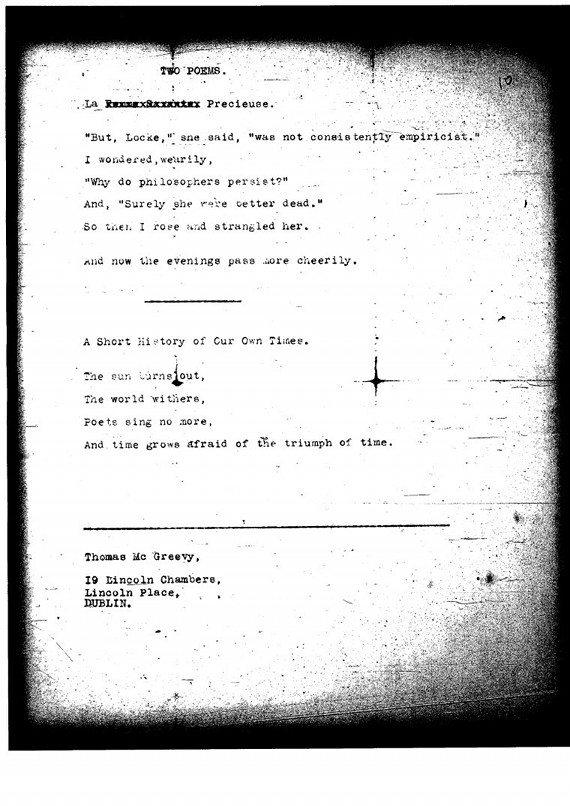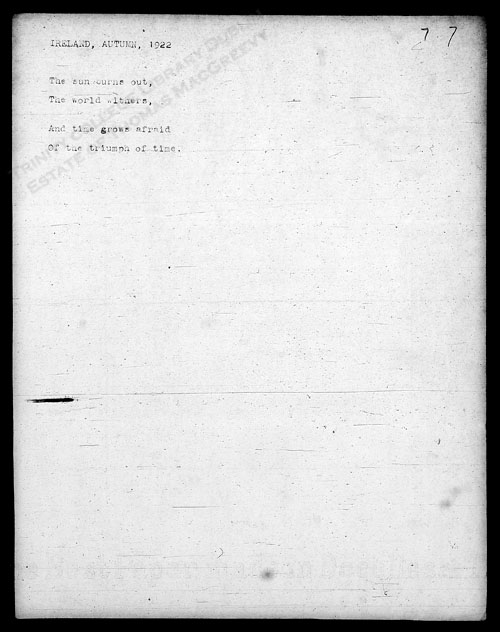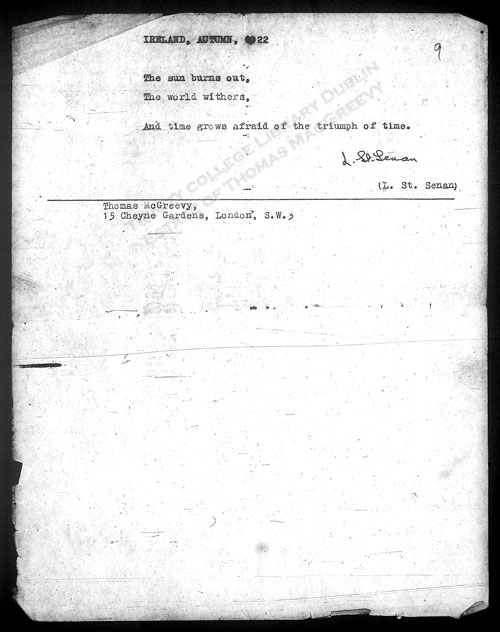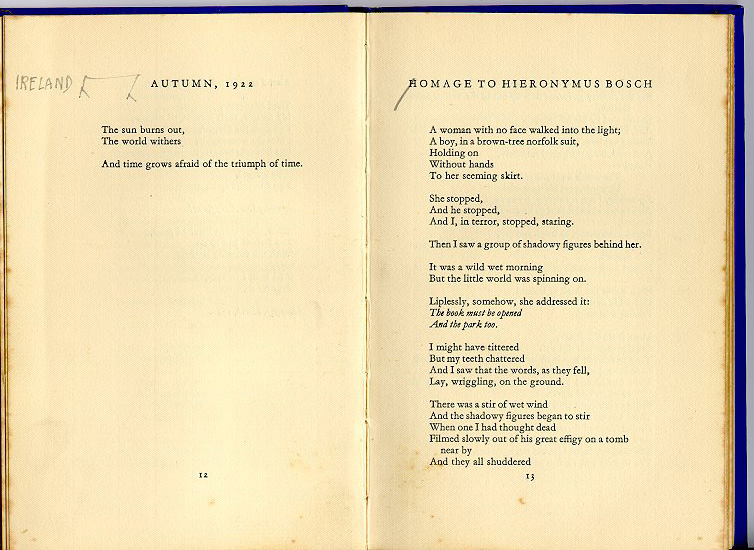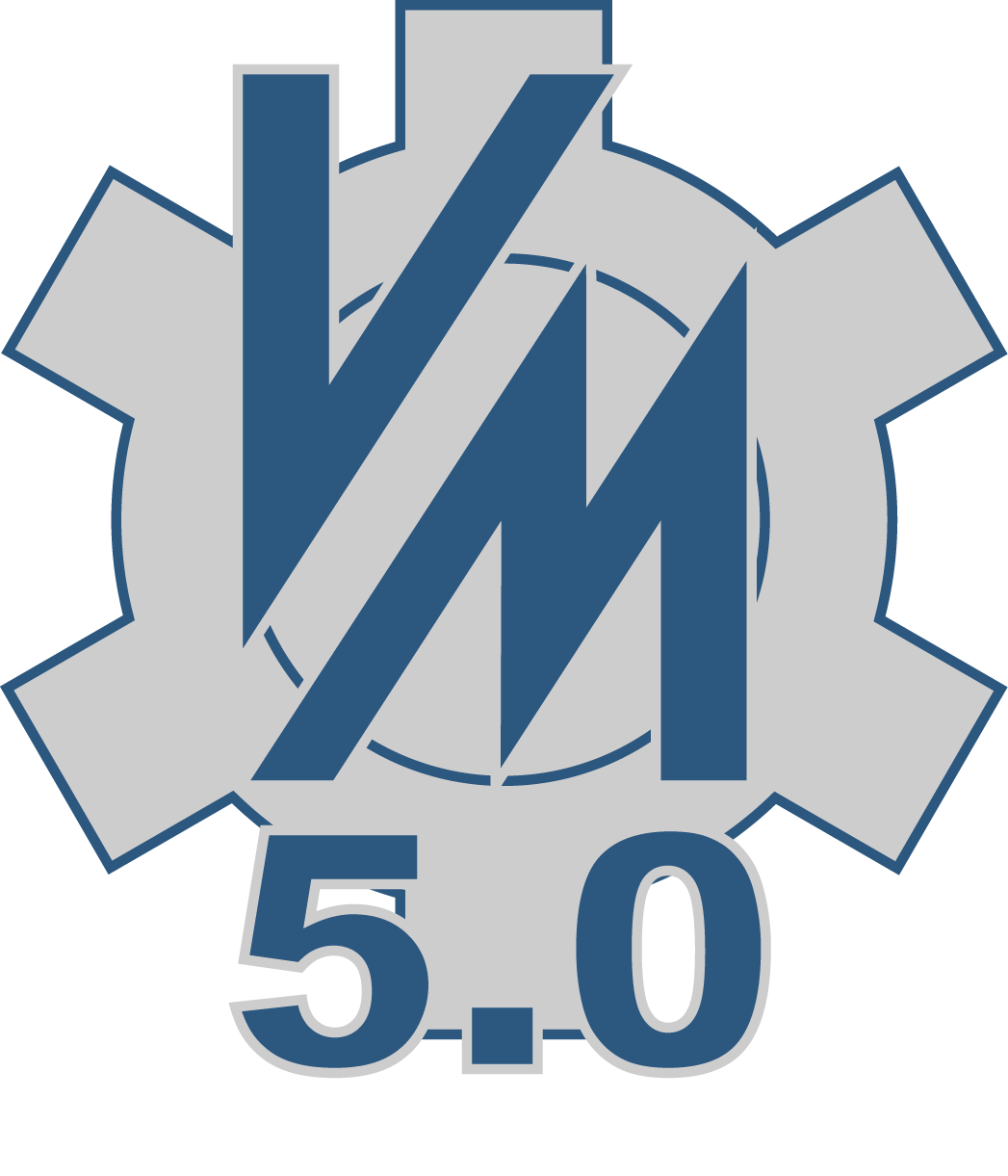 Bibliographic Information
Bibliographic Information
Autumn, 1922
by Thomas MacGreevy
Original Source
Diplomatic editions of MacGreevy's poetry were created from
Witness List
- Witness t7989-1-10: 'A Short History of Our Own Time' (TCD MS 7989/1/10)
- Witness t7989-1-8: 'Civil War', which was deleted and replaced with 'Ireland, Autumn 1922' (TCD MS 7989/1/8)
- Witness t7989-1-7: 'Ireland Autumn, 1922' (TCD MS 7989/1/7)
- Witness t7989-1-9: 'Ireland, Autumn, 1922 (TCD MS 7989/1/9)
- Witness pub: published in Poems under the title 'Autumn, 1922'
Textual Notes
Electronic Edition Information:
Responsibility Statement:
- Text Encoding by Susan Schreibman and Jarom McDonald
Publication Details:
Published by Susan Schreibman.
The Thomas MacGreevy Archive http://macgreevy.orgThomas MacGreevy's poetry is reprinted here with the kind permission of Margaret Farrington and the late Elizabeth Ryan.
This poem is being made available for demonstration purposes only. It may not be reproduced without explicit permission from the copyright holder. For copyright information, please contact Susan Schreibman at susan.schreibman[AT]gmail.com
Encoding Principles
This is a demonstration document for the Versioning Machine of parallel segmentation encoding utilising TEIP5. This revision incorporates location-referenced encoding to ensure that every variation can be compared across versions.





The alternative titles MacGreevy experimented with provide the key to this very short poem. By the autumn of 1922 over six years had passed since Patrick Pearse had proclaimed the Irish Republic in Dublin's General Post Office. The country had seen the heart of its capital destroyed by the fires of Easter 1916, and this was followed after the Seinn Fein victory in the 1918 election by an extended campaign of guerilla warfare against the British with its reprisals and counter-reprisals.
In the end, nationalist Ireland was divided into bitterly opposing camps, and engaged in civil war over the terms of the agreement reached in London in December 1921. The new national institutions that emerged did so more through the passage of time than as the expression of any national ideal or vision. MacGreevy's poem captures the despair and weariness of a nation torn apart by war and bitter political divisions.
The fifth of six allegorical triumphs in Petrarch's Trionfi is the Triumph of Time. Petrarch's Triumphs, often depicted as Father Time in his chariot surrounded by symbolic devices such as the scythe and hourglass, were frequently represented by Baroque and Renaissance artists.
MacGreevy, however, may be thinking of one or more of the paintings that he saw during his visit to the Prado in Madrid in 1924. One is Goya's Saturn [Time] Devouring His Son, and the other is Pieter Brueghel the Elder's The Triumph of Death, which depicts a whole society visited by death riding a pale horse (using imagery from the Apocalypse) against a background of barren landscape and a darkened sky.





The alternative titles MacGreevy experimented with provide the key to this very short poem. By the autumn of 1922 over six years had passed since Patrick Pearse had proclaimed the Irish Republic in Dublin's General Post Office. The country had seen the heart of its capital destroyed by the fires of Easter 1916, and this was followed after the Seinn Fein victory in the 1918 election by an extended campaign of guerilla warfare against the British with its reprisals and counter-reprisals.
In the end, nationalist Ireland was divided into bitterly opposing camps, and engaged in civil war over the terms of the agreement reached in London in December 1921. The new national institutions that emerged did so more through the passage of time than as the expression of any national ideal or vision. MacGreevy's poem captures the despair and weariness of a nation torn apart by war and bitter political divisions.
The fifth of six allegorical triumphs in Petrarch's Trionfi is the Triumph of Time. Petrarch's Triumphs, often depicted as Father Time in his chariot surrounded by symbolic devices such as the scythe and hourglass, were frequently represented by Baroque and Renaissance artists.
MacGreevy, however, may be thinking of one or more of the paintings that he saw during his visit to the Prado in Madrid in 1924. One is Goya's Saturn [Time] Devouring His Son, and the other is Pieter Brueghel the Elder's The Triumph of Death, which depicts a whole society visited by death riding a pale horse (using imagery from the Apocalypse) against a background of barren landscape and a darkened sky.





The alternative titles MacGreevy experimented with provide the key to this very short poem. By the autumn of 1922 over six years had passed since Patrick Pearse had proclaimed the Irish Republic in Dublin's General Post Office. The country had seen the heart of its capital destroyed by the fires of Easter 1916, and this was followed after the Seinn Fein victory in the 1918 election by an extended campaign of guerilla warfare against the British with its reprisals and counter-reprisals.
In the end, nationalist Ireland was divided into bitterly opposing camps, and engaged in civil war over the terms of the agreement reached in London in December 1921. The new national institutions that emerged did so more through the passage of time than as the expression of any national ideal or vision. MacGreevy's poem captures the despair and weariness of a nation torn apart by war and bitter political divisions.
The fifth of six allegorical triumphs in Petrarch's Trionfi is the Triumph of Time. Petrarch's Triumphs, often depicted as Father Time in his chariot surrounded by symbolic devices such as the scythe and hourglass, were frequently represented by Baroque and Renaissance artists.
MacGreevy, however, may be thinking of one or more of the paintings that he saw during his visit to the Prado in Madrid in 1924. One is Goya's Saturn [Time] Devouring His Son, and the other is Pieter Brueghel the Elder's The Triumph of Death, which depicts a whole society visited by death riding a pale horse (using imagery from the Apocalypse) against a background of barren landscape and a darkened sky.
The fifth of six allegorical triumphs in Petrarch's Trionfi is the Triumph of Time. Petrarch's Triumphs, often depicted as Father Time in his chariot surrounded by symbolic devices such as the scythe and hourglass, were frequently represented by Baroque and Renaissance artists.
MacGreevy, however, may be thinking of one or more of the paintings that he saw during his visit to the Prado in Madrid in 1924. One is Goya's Saturn [Time] Devouring His Son, and the other is Pieter Brueghel the Elder's The Triumph of Death, which depicts a whole society visited by death riding a pale horse (using imagery from the Apocalypse) against a background of barren landscape and a darkened sky.





The alternative titles MacGreevy experimented with provide the key to this very short poem. By the autumn of 1922 over six years had passed since Patrick Pearse had proclaimed the Irish Republic in Dublin's General Post Office. The country had seen the heart of its capital destroyed by the fires of Easter 1916, and this was followed after the Seinn Fein victory in the 1918 election by an extended campaign of guerilla warfare against the British with its reprisals and counter-reprisals.
In the end, nationalist Ireland was divided into bitterly opposing camps, and engaged in civil war over the terms of the agreement reached in London in December 1921. The new national institutions that emerged did so more through the passage of time than as the expression of any national ideal or vision. MacGreevy's poem captures the despair and weariness of a nation torn apart by war and bitter political divisions.
The fifth of six allegorical triumphs in Petrarch's Trionfi is the Triumph of Time. Petrarch's Triumphs, often depicted as Father Time in his chariot surrounded by symbolic devices such as the scythe and hourglass, were frequently represented by Baroque and Renaissance artists.
MacGreevy, however, may be thinking of one or more of the paintings that he saw during his visit to the Prado in Madrid in 1924. One is Goya's Saturn [Time] Devouring His Son, and the other is Pieter Brueghel the Elder's The Triumph of Death, which depicts a whole society visited by death riding a pale horse (using imagery from the Apocalypse) against a background of barren landscape and a darkened sky.





The alternative titles MacGreevy experimented with provide the key to this very short poem. By the autumn of 1922 over six years had passed since Patrick Pearse had proclaimed the Irish Republic in Dublin's General Post Office. The country had seen the heart of its capital destroyed by the fires of Easter 1916, and this was followed after the Seinn Fein victory in the 1918 election by an extended campaign of guerilla warfare against the British with its reprisals and counter-reprisals.
In the end, nationalist Ireland was divided into bitterly opposing camps, and engaged in civil war over the terms of the agreement reached in London in December 1921. The new national institutions that emerged did so more through the passage of time than as the expression of any national ideal or vision. MacGreevy's poem captures the despair and weariness of a nation torn apart by war and bitter political divisions.
The fifth of six allegorical triumphs in Petrarch's Trionfi is the Triumph of Time. Petrarch's Triumphs, often depicted as Father Time in his chariot surrounded by symbolic devices such as the scythe and hourglass, were frequently represented by Baroque and Renaissance artists.
MacGreevy, however, may be thinking of one or more of the paintings that he saw during his visit to the Prado in Madrid in 1924. One is Goya's Saturn [Time] Devouring His Son, and the other is Pieter Brueghel the Elder's The Triumph of Death, which depicts a whole society visited by death riding a pale horse (using imagery from the Apocalypse) against a background of barren landscape and a darkened sky.
 Textual Notes
Textual Notes
The alternative titles MacGreevy experimented with provide the key to this very short poem. By the autumn of 1922 over six years had passed since Patrick Pearse had proclaimed the Irish Republic in Dublin's General Post Office. The country had seen the heart of its capital destroyed by the fires of Easter 1916, and this was followed after the Seinn Fein victory in the 1918 election by an extended campaign of guerilla warfare against the British with its reprisals and counter-reprisals.
In the end, nationalist Ireland was divided into bitterly opposing camps, and engaged in civil war over the terms of the agreement reached in London in December 1921. The new national institutions that emerged did so more through the passage of time than as the expression of any national ideal or vision. MacGreevy's poem captures the despair and weariness of a nation torn apart by war and bitter political divisions.
The fifth of six allegorical triumphs in Petrarch's Trionfi is the Triumph of Time. Petrarch's Triumphs, often depicted as Father Time in his chariot surrounded by symbolic devices such as the scythe and hourglass, were frequently represented by Baroque and Renaissance artists.
MacGreevy, however, may be thinking of one or more of the paintings that he saw during his visit to the Prado in Madrid in 1924. One is Goya's Saturn [Time] Devouring His Son, and the other is Pieter Brueghel the Elder's The Triumph of Death, which depicts a whole society visited by death riding a pale horse (using imagery from the Apocalypse) against a background of barren landscape and a darkened sky.
The fifth of six allegorical triumphs in Petrarch's Trionfi is the Triumph of Time. Petrarch's Triumphs, often depicted as Father Time in his chariot surrounded by symbolic devices such as the scythe and hourglass, were frequently represented by Baroque and Renaissance artists.
MacGreevy, however, may be thinking of one or more of the paintings that he saw during his visit to the Prado in Madrid in 1924. One is Goya's Saturn [Time] Devouring His Son, and the other is Pieter Brueghel the Elder's The Triumph of Death, which depicts a whole society visited by death riding a pale horse (using imagery from the Apocalypse) against a background of barren landscape and a darkened sky.

